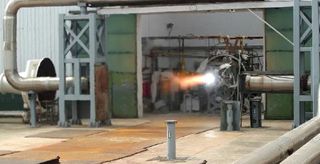China tests engine for new crewed moon rocket (photo)
The tests mark the latest progress in the country's human spaceflight plans.

China has successfully conducted a hot-fire test of a new engine that will help power a next-generation rocket capable of launching astronauts to the moon.
"The long-distance and multiple ignition tests of the engine have been successfully completed, indicating that it is ready to enter the next stage of prototype sample development," the state-run media outlet Xinhua reported this month.
The test examined the engine's key technologies, components and performance, the reliability of the ignition system and a real-time fault diagnosis system, according to officials with the China Aerospace Science and Technology Corporation (CASC), the country's state-owned main space contractor, which is developing the liquid hydrogen-liquid oxygen rocket engine.
Related: The latest news about China's space program
China released a space white paper earlier this year outlining key tasks for the next five years (2021-2025) that included language indicating that the first liftoff of a new crew launch vehicle would take place before the end of the period.
The first version to be tested will be a two-stage rocket capable of sending a next-generation crew spacecraft to China's Tiangong space station.
The larger, three-stage version — which will include the new engine — will be able to send a larger variant of the next-gen crew spacecraft to the moon, potentially before the end of the decade.
Get the Space.com Newsletter
Breaking space news, the latest updates on rocket launches, skywatching events and more!
Follow us on Twitter @Spacedotcom or on Facebook.
Join our Space Forums to keep talking space on the latest missions, night sky and more! And if you have a news tip, correction or comment, let us know at: community@space.com.

Andrew is a freelance space journalist with a focus on reporting on China's rapidly growing space sector. He began writing for Space.com in 2019 and writes for SpaceNews, IEEE Spectrum, National Geographic, Sky & Telescope, New Scientist and others. Andrew first caught the space bug when, as a youngster, he saw Voyager images of other worlds in our solar system for the first time. Away from space, Andrew enjoys trail running in the forests of Finland. You can follow him on Twitter @AJ_FI.
